To meet the challenges and demands of an ever-evolving world, we are proud to offer a range of organic carpets. Furthermore, we offer accessories such as towels and bed linen made of organic cotton. Both the carpets and accessories are certified by GOTS to ensure the high quality of the products. In our organic carpet range, there’s a variety of no less than 120 organic colors. Due to certified pasture and vegetable dye, we can be certain that our wool is truly organic.
Archive for the ‘Singelsidor – Lösa mattor’ Category
Material
Our producer of rugs provides several different pile materials. Below you can find in-depth information on some of the most common choices of material.
Wool
It is no coincidence that wool has been used in production of rugs through all years. Actually, wool is the most common and many times the most favorable choice. Wool is a durable natural material. Its fibers have an overlapping outer structure, much like roof tiles. This feature, combined with the wool’s natural grease, helps to repulse dirt, and ensures that the dirt does not penetrate into the fibers. Wool also works as a good silencer. Perhaps most important feature, however, is that wool has a very high ignition level, burns slowly, has a low heat output, low combustion heat, and neither melts nor drops. In addition, wool, when used in carpets, contributes to a lesser extent to toxic gases and smoke compared with other floor products. Wool carpets are therefore used in environments with high safety standards such as trains and airplanes.
Tencel/Viscose
Tencel / Viscose offers a fantastic shine and a soft, lovely feel like that breathes luxury. Since the shade of the fiber changes depending on how the pile lies, an appealing irregularity is created in the carpet. No wonder they have become so sought-after material choices. However, we want to point out that Tencel / Viscose should be used with caution. These fibers are not as durable and resilient as wool. Therefore, we recommend that Tencel / Viscose be mixed with wool that can help “protect” the fiber, if the carpet is to be placed in a highly traffic area.
Polyester
The biggest advantage of polyester is probably that the fiber is extremely color resistant while also good at rejecting dirt and spillage. Like Tencel / Viscose, polyester has an outstanding luster that contributes to a luxurious feel. However, it is not the only feature that polyester has in common with Tencel / Viscose. Even polyester is easily treading and does not have the same ability to regain its original shape as wool has. We recommend a mix of wool for areas with a lot of foot traffic.
Colors
BCC Color Box
In the suitcase with color samples (also called “BCC color box”), which you as a customer has access to when you do business with us, there are over 500 different colors and shades to choose from. It also guarantees that you get exactly the colors that you ordered. The yarns are spun and colored on the factory site, which means that our manufacturer has full control all along the production chain.
BIL 60
As a complement to the BCC Color Box, we offer a smaller box; BIL 60. This box contains a smaller number of colors in shades that complements the ones in the BCC.
OW Color Box
We would also like to present to you our “Organic Weave color box” with 120 organic colors that are used in our organic wool and cotton carpets range. Thanks to free range sheep only being fed with certified fodder, we can be certain that our wool is truly organic.
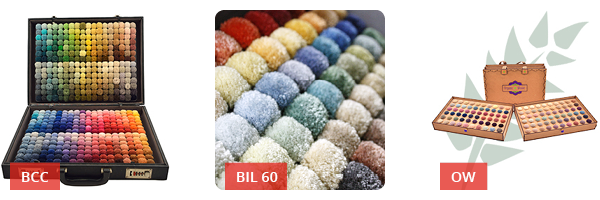
Technique
There are many indications that rugs were manufactured thousands of years before the birth of Christ, and the oldest preserved rug is considered to originate from around 400 B.C. During the impressive number of years that mankind has made rugs, different techniques have also evolved, and continue to do so even today. Our manufacturer masters several of these techniques and has a long tradition of producing rugs within the family.
Hand-tufted rugs
The design is imprinted by hand using a stencil on a weave mounted on the tufting frame. The tufter manually fills each design section, following the color position as marked. After the rug is tufted, latex and backing is attached to it. It is then hand-sheared and carved as desired.
Hand-knotted rugs – Tibetan weave
The cotton warp is mounted on a handloom. The weaver inserts the yarn for making a pile, using a rod. The weaver uses a design map, following the color position of each knot. After the rug is taken off the loom, it is hand-washed and hand-sheared.
Hand-knotted rugs – Persian weave
The cotton warp is mounted on a handloom. The weaver inserts the yarn that will make up the pile by using the fingers only. The weaver uses a design map, following the color position of each knot. After the rug is taken off the loom, it is hand-washed, hand-sheared and carved as desired.
Handmade shag
The cotton fabric is inserted in a tailoring machine on table pile. Latex and backing is attached to it and thereafter hand-sheared.
Hand-woven dhurrie
The cotton warp is mounted on a handloom. The weaver inserts the yarn for making a pattern using his fingers only.




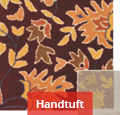
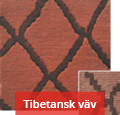
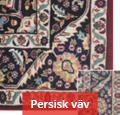
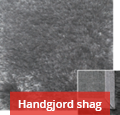
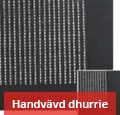
Recent Comments